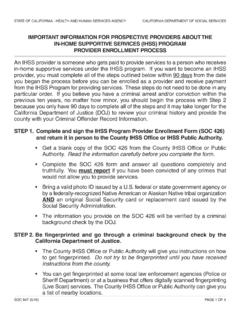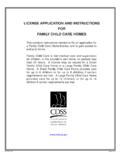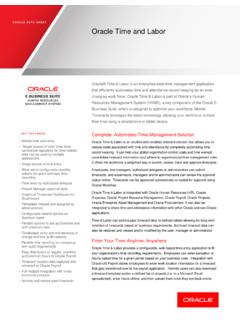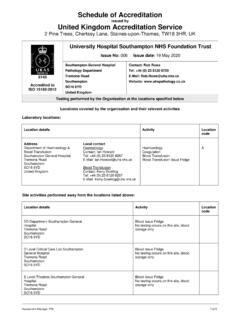Transcription of State of California Health and Human Services Agency
1 State of California Health and Human Services Agency JENNIFER KENT DIRECTOR DIRECTOR EDMUND G. BROWN JR. GOVERNOR October 7, 2016 ALL COUNTY LETTER (ACL) NO. 16-84 MENTAL Health SUBSTANCE USE DISORDER Services (MHSUDS) INFORMATION NOTICE NO. 16-049 TO: ALL COUNTY BEHAVIORAL Health PROGRAM DIRECTORS ALL COUNTY WELFARE DIRECTORS ALL COUNTY FISCAL OFFICERS ALL COUNTY ADMINISTRATIVE OFFICERS ALL CHIEF PROBATION OFFICERS ALL TITLE IV-E AGREEMENT TRIBES COUNTY WELFARE DIRECTORS ASSOCIATION OF California COUNTY BEHAVIORAL Health DIRECTORS ASSOCIATION CHIEF PROBATION OFFICERS OF California COUNTY COUNCIL OF COMMUNITY BEHAVIORAL Health AGENCIES SUBJECT: REQUIREMENTS AND GUIDELINES FOR CREATING AND PROVIDING A CHILD AND FAMILY TEAM REFERENCE: ASSEMBLY BILL (AB) 403 and AB 1997 (CHAPTER 773, STATUTES OF 2015 and CHAPTER 612, STATUTES OF 2016) WELFARE AND INSTITUTIONS CODE , 832, PATHWAYS TO MENTAL Health Services CORE PRACTICE MODEL GUIDE Executive Summary This ACL and MHSUDS Information Notice provides information and guidance regarding the use of child and family teaming to deliver child welfare Services , as required by Assembly Bill (AB) 403, commonly known as the Continuum of Care Reform (CCR).
2 Signed by Governor Jerry Brown in October 2015, the CCR makes sweeping changes to California s child welfare system, with implementation planned to occur in stages between now and 2021. The intent of the CCR is to have children and youth, who must live apart from their biological parents, live in a permanent home with a committed adult(s) who can meet their needs. The CCR changes also include, but are not limited to, providing Services and supports to children, youth, and their families that reduce reliance on congregate care, thereby increasing placements in home-based settings. ALL COUNTY LETTER NO. 16-84 MHSUDS INFORMATION NO. 16-049 Page Two One of the CCR s most fundamental principles is that child welfare Services are most effective when delivered in the context of a child or youth and family-centered, child and family team (CFT) that shares responsibility to assess, plan, intervene, monitor and refine Services over time.
3 Welfare and Institutions Code, Section (c) and (d) require that county placing agencies convene a CFT meeting as defined in Section 16501 to identify supports and Services that are needed to achieve permanency, enable a child to live in the least restrictive family setting, and promote normal childhood experiences. This requirement applies to all children and youth residing in a group home with an existing case plan or children and youth who come into the child welfare foster care placement after January 1, 2017, including probation youth in foster care and non-minor dependents. Background Team-based approaches are not new to California . Beginning in 1997 with Wraparound, team-driven service models such as Functional Family Therapy, Safety Organized Practice, and Team Decision Making have been in use across the State . More recently, the Pathways to Mental Health Services - Core Practice Model Guide provided a comprehensive description of a CFT that reflects what was already occurring in practice; combining the structure of professional interdisciplinary teams with the strengths-based and inclusive principles of family-centered care to make informed decisions.
4 This State approved guide contains valuable guidance about effective CFT processes. Evidence-based and promising practices in child welfare and probation increasingly rely on youth and family engagement and teaming processes as effective methods to support children, youth, and families and include system partners in the planning, delivery and management of necessary Services . As team-based practices have grown in California , so has the recognition of their success in improving outcomes for children, youth, and their families. The CCR builds on this success to provide children and youth who come into contact with California s child welfare and probation systems with this strategy that improves safety, permanency, and well-being. Child and Family Team Model Overview A CFT is a group of individuals that includes the child or youth, family members, professionals, natural community supports, and other individuals identified by the family who are invested in the child, youth, and family s success.
5 In addition to mandated participation of involved public Agency representatives, the composition of the team is driven by family members preferences. Successful CFTs include persons with natural supportive relationships with the family, so that the family s support system will continue to exist after formal Services are completed. The CFT s role is to include family members in defining and reaching identified goals for the child. The individuals on the team work together to identify each family member s strengths and needs, based on relevant life domains, to develop a child, youth, and family-centered case plan. The plan articulates specific strategies for achieving the child, youth, and/or family s goals based on addressing identified needs, public safety, including following ALL COUNTY LETTER NO. 16-84 MHSUDS INFORMATION NO. 16-049 Page Three related court orders, and building on or developing functional strengths.
6 The CFT typically conducts and coordinates its work through a CFT meeting, which is discussed in detail below. It is important to recognize, however, that the CFT and a CFT meeting are not the same. The CFT is a group of people; a CFT meeting is a functional structure and process of engaging the family and their service teams in thoughtful and effective planning. The CFT process reflects a belief that families have capacity to address their problems and achieve success if given the opportunity and supports to do so. Engagement with families is fundamental to the CFT process. Working with children, youth, and families as partners results in plans that are developed collaboratively and in a shared decision-making process. The family members hold significant power of choice when strategies are defined. The CFT process reflects the culture and preferences of children, youth, and families, building on their unique values and capacities, and eliciting the participation of everyone on the team.
7 It is important to recognize that at times the child, youth, and family have their own unique cultures. In those cases, care must be taken to integrate their cultures into the plan. Team members should help children, youth, and families recognize their strengths, and encourage them and support them to develop solutions that match their preferences. The team must respect and support the power of learning from mistakes when strategies do not work as intended so that the plan can be revised to improve outcomes. Composition of Child and Family Teams For children and youth in the child welfare or probation systems, the placing Agency is responsible for engaging members of the CFT. The CFT composition always includes the child or youth, family members, the current caregiver, a representative from the placing Agency , and other individuals identified by the family as being important.
8 A CFT shall also include a representative of the child or youth s tribe or Indian custodian, behavioral Health staff, foster family Agency social worker, or short-term residential therapeutic program (STRTP) representative, when applicable. Other professionals that may be included are: youth or parent partners, public Health providers, Court Appointed Special Advocates, school personnel, or others. In addition to formal supports, effective CFT processes support and encourage family members to invite the participation of individuals who are part of their own network of informal support. This may include extended family, friends, neighbors, coaches, clergy, co-workers, or others who the family has identified as a potential source of support. Family members may be reluctant, for a variety of reasons, to identify and invite friends or neighbors to participate. Family members may be angry or ashamed of being involved with child welfare, behavioral Health , or probation; they may subscribe to cultural norms that do not accommodate sharing of personal information with outsiders.
9 Engagement may also be challenging for families experiencing serious mental illness and/or substance use disorders, or further complicated by the historical or current impact of trauma. ALL COUNTY LETTER NO. 16-84 MHSUDS INFORMATION NO. 16-049 Page Four Professionals can work to mitigate family member reluctance by being patient, offering reassurance and encouragement, and demonstrating respect and cultural humility. It is important to explain how the inclusion of others can directly support the family members to achieve their goals in order to exit child welfare or probation Services in a timely and effective manner. Individuals with lived experience ( parent partners, youth partners/mentors) can be useful by being mentors and advocates who have personally experienced many of the same challenges and feelings through their own contact with the child welfare, behavioral Health , or probation system(s).
10 The parent partner s or youth mentor s unique role often promotes clarity and understanding for the family. As families move through the CFT process, family members will often come to recognize their own strengths and experience the power of strengths-based support that comes without judgment. Over time and with growing trust, reluctance may fade and inclusion of natural supports will grow. Team membership is intentionally flexible and dynamic, so team participants will continue to change as needs change. Identified natural supports will move into a more significant role, as professionals work towards transitioning out of the team. Confidentiality Confidentiality and information sharing practices are key elements throughout the CFT process, and they must be designed to protect children, youth and families rights to privacy without creating barriers to receiving Services .

















